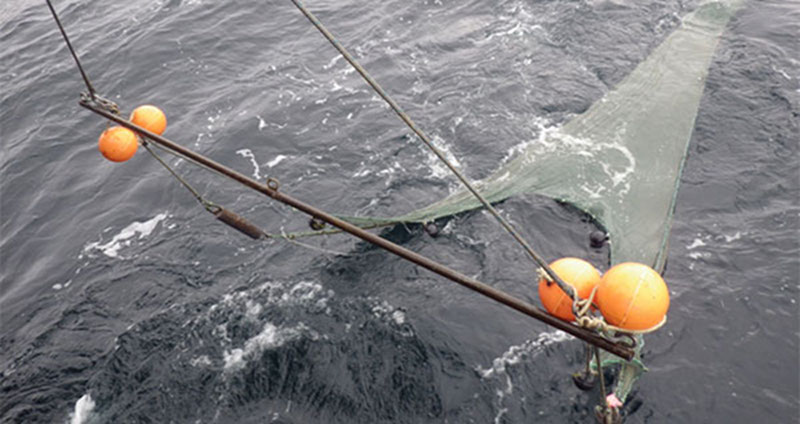Trawls
Trawls, which are nets towed behind a boat to collect organisms, have been used by fishers for centuries. Trawls can be divided into three categories based on where they sample the water column: surface, midwater, and bottom. They may be divided further by their design and the materials used in their construction. The type of trawl used by researchers is determined by the type of organisms they are collecting and/or which part of the water column they are interested in sampling.

A beam trawl in the water, collecting samples of marine life for scientists to sort through. Image courtesy of Bodil Bluhm and Katrin Iken, 2012 RUSALCA Expedition, RAS-NOAA. Download image (jpg, 76 KB).
Elusive Creatures, Vast Habitat
The midwater zone is important to scientists and fishers because it is inhabited by nekton. Nekton are fast-moving organisms ranging from small shrimp and fish to whales. Extremely strong swimmers, nekton can overcome many ocean currents and swim through turbulent water. Many species regularly undertake long-distance migrations. One example is the foot-long herring, which may travel over 3,000 kilometers each year. The midwater region is especially important because the creatures that inhabit it constitute the majority of the world's seafood. Understanding the ecology of midwater organisms and their vast environment can provide us with better information to manage these important natural resources and prevent their overexploitation.
During the last several decades, scientists have discovered that if they use a high frequency echosounder, which essentially is a sophisticated type of sonar, they can identify specific species in the midwater zone based on the organisms' acoustic images, or reflections. While echosounders are useful, they do not provide certain quantitative data that researchers need to understand the ecology of these organisms and the midwater zone. To collect quantitative data, such as biomass, length and weight, and age class distributions, researchers must gather representational samples of the nekton species and take direct measurements of them. The best way to do this is by employing trawls.
Designing the Right Tool
The Isaacs-Kidd midwater trawl (IKMT) is designed specifically to collect biological specimens in the midwater zone. It is a long, round net approximately 20 feet long, with a series of hoops decreasing in size extending from the mouth of the net to the rear (cod) end, which measures an additional 5 feet in length. The hoops maintain the shape of the net during towing. The mouth of the net is approximately five feet wide by six feet high, and is attached to a wide, v-shaped, rigid diving vane sometimes called a depressor. The vane keeps the mouth of the net open during towing and exerts a depressing force. This force maintains the trawl at a designated depth for the duration of the sampling period. While most trawls must be towed at speeds of one to two knots because of the high level of drag exerted by the net in the water, an IKMT can be towed at speeds as high as five knots.

Crew members are deploying an Isaacs-Kidd midwater trawl to sample species in the midwater zone of the ocean (660 feet to 3,300 feet). One crewman holds the trawl by its "depressor" vane, a device designed to keep the net stable at a specific depth. Image courtesy of NOAA. Download image (jpg, 33 KB).
The IKMT’s large mouth opening and capacity for fast towing speeds enables it to capture a wider range of relatively large and more active organisms than smaller nets. In addition, its fine mesh allows it to snag animals that are not retained in the large trawl nets that are used for commercial fishing. Thus, it is well suited for capturing an array of fishes, squids and shrimp that inhabit the midwater zone. To make sample collection easier, the IKMT is always used in conjunction with echosounders, which provide a target area for the researchers to sample.
Midwater trawling is a perfect example of how new technologies, such as echosounders and advanced net design, can be combined with older fishing technologies like nets to study the ecology of the mysterious midwater zone and its inhabitants.